Lifespan Nutrition Medical Lifes Assignment
VerifiedAdded on 2022/09/15
|10
|2467
|15
AI Summary
Contribute Materials
Your contribution can guide someone’s learning journey. Share your
documents today.
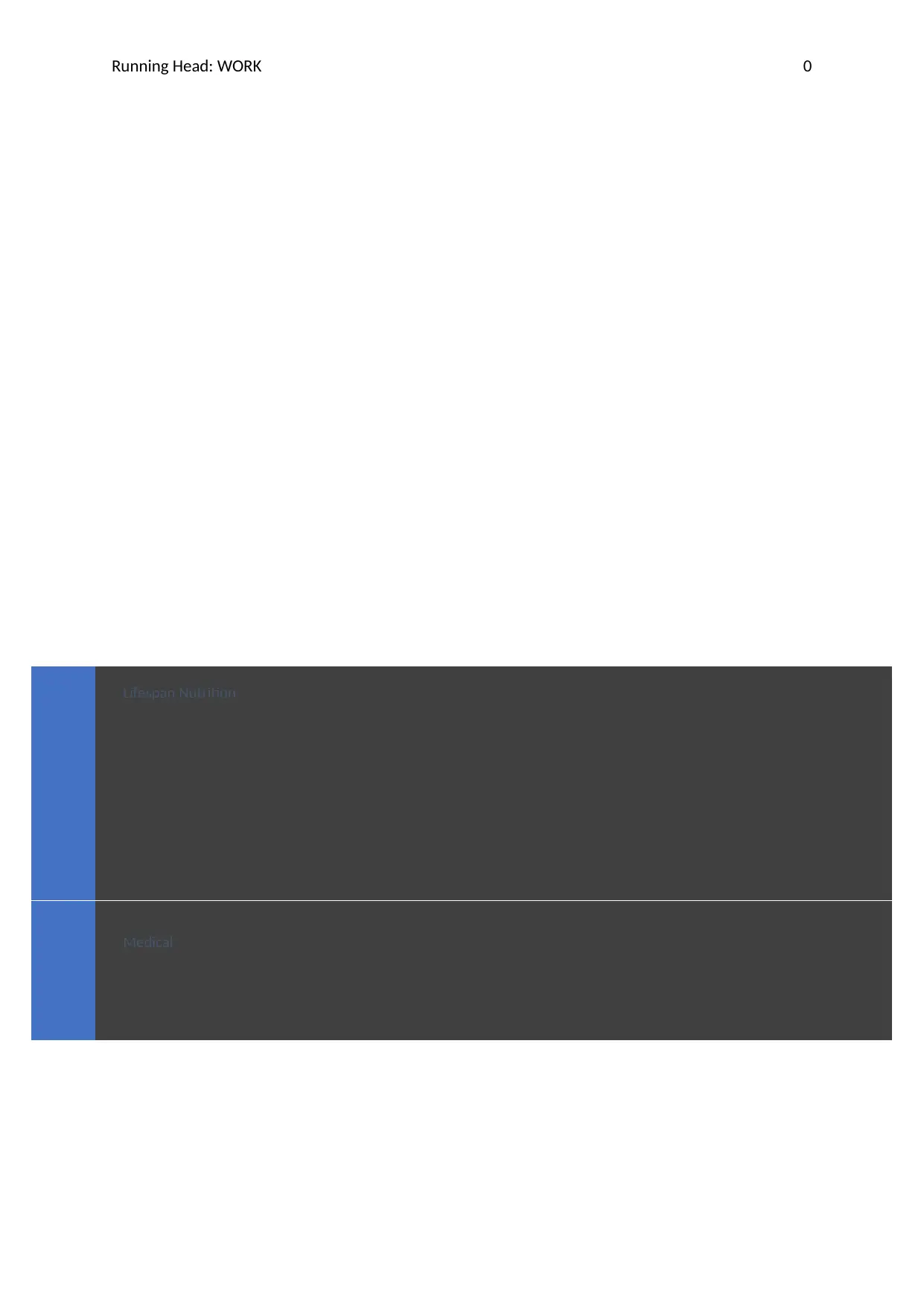
Lifespan Nutrition
Medical
Running Head: WORK 0
Medical
Running Head: WORK 0
Secure Best Marks with AI Grader
Need help grading? Try our AI Grader for instant feedback on your assignments.
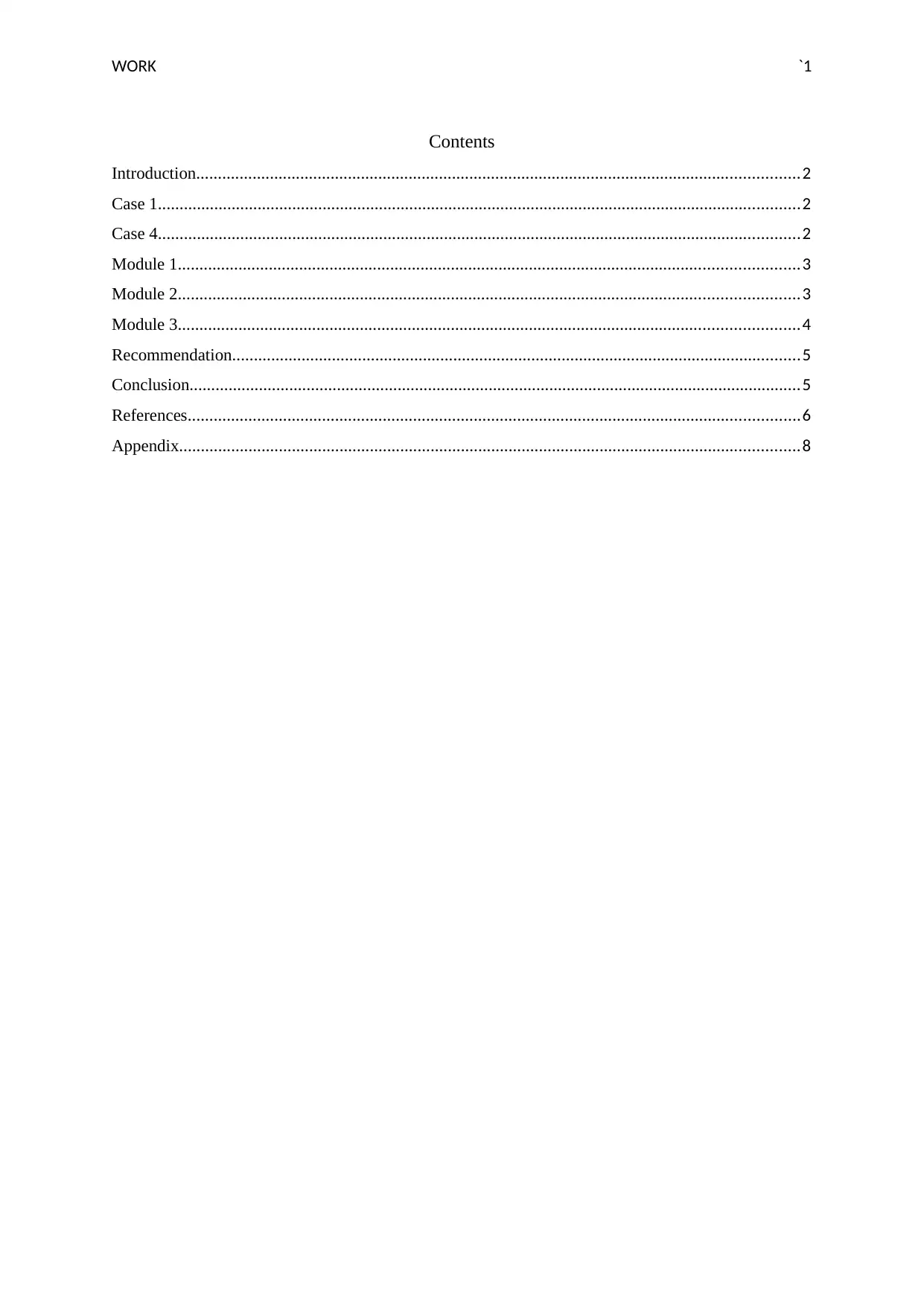
WORK `1
Contents
Introduction...........................................................................................................................................2
Case 1....................................................................................................................................................2
Case 4....................................................................................................................................................2
Module 1...............................................................................................................................................3
Module 2...............................................................................................................................................3
Module 3...............................................................................................................................................4
Recommendation...................................................................................................................................5
Conclusion.............................................................................................................................................5
References.............................................................................................................................................6
Appendix...............................................................................................................................................8
Contents
Introduction...........................................................................................................................................2
Case 1....................................................................................................................................................2
Case 4....................................................................................................................................................2
Module 1...............................................................................................................................................3
Module 2...............................................................................................................................................3
Module 3...............................................................................................................................................4
Recommendation...................................................................................................................................5
Conclusion.............................................................................................................................................5
References.............................................................................................................................................6
Appendix...............................................................................................................................................8
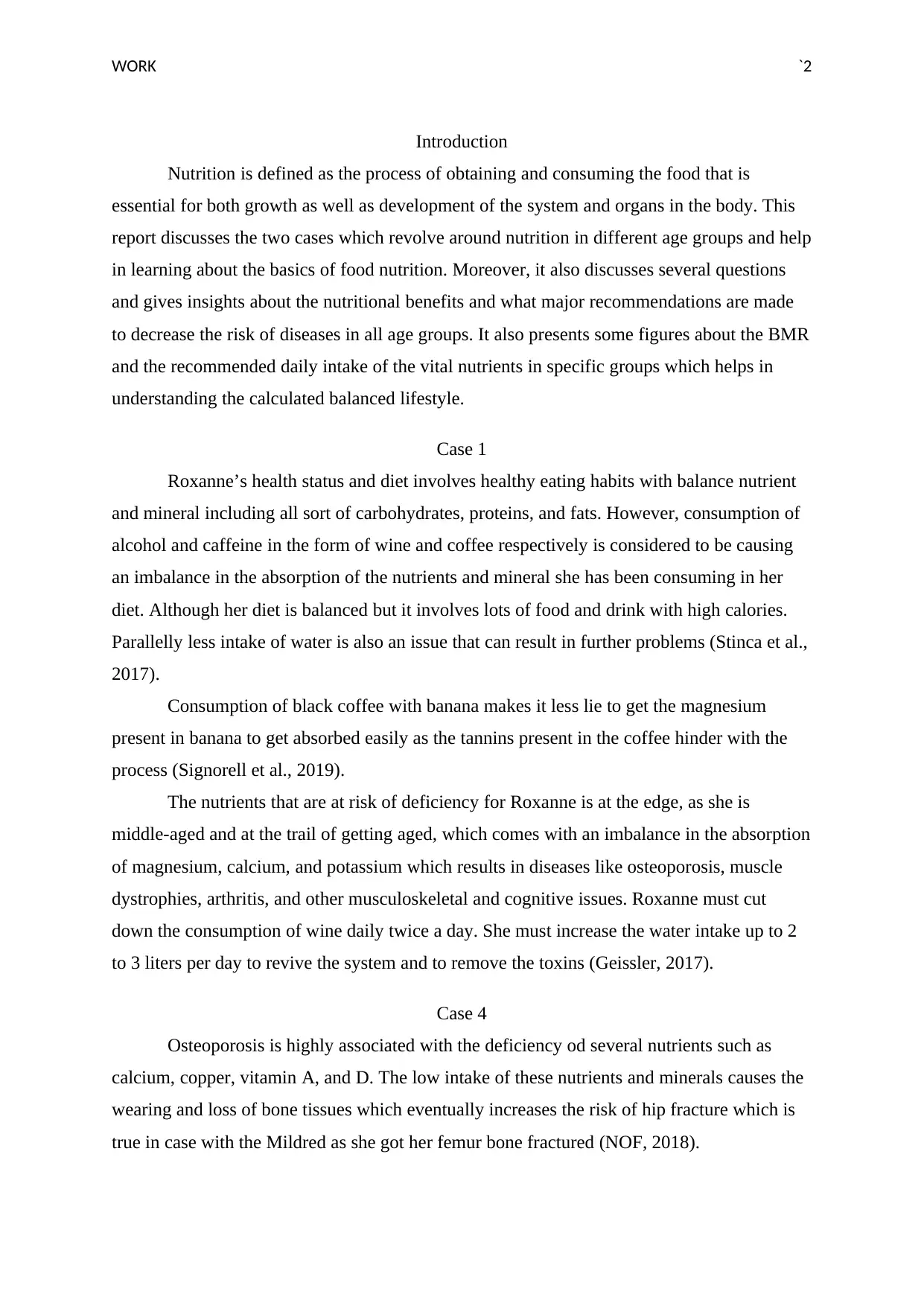
WORK `2
Introduction
Nutrition is defined as the process of obtaining and consuming the food that is
essential for both growth as well as development of the system and organs in the body. This
report discusses the two cases which revolve around nutrition in different age groups and help
in learning about the basics of food nutrition. Moreover, it also discusses several questions
and gives insights about the nutritional benefits and what major recommendations are made
to decrease the risk of diseases in all age groups. It also presents some figures about the BMR
and the recommended daily intake of the vital nutrients in specific groups which helps in
understanding the calculated balanced lifestyle.
Case 1
Roxanne’s health status and diet involves healthy eating habits with balance nutrient
and mineral including all sort of carbohydrates, proteins, and fats. However, consumption of
alcohol and caffeine in the form of wine and coffee respectively is considered to be causing
an imbalance in the absorption of the nutrients and mineral she has been consuming in her
diet. Although her diet is balanced but it involves lots of food and drink with high calories.
Parallelly less intake of water is also an issue that can result in further problems (Stinca et al.,
2017).
Consumption of black coffee with banana makes it less lie to get the magnesium
present in banana to get absorbed easily as the tannins present in the coffee hinder with the
process (Signorell et al., 2019).
The nutrients that are at risk of deficiency for Roxanne is at the edge, as she is
middle-aged and at the trail of getting aged, which comes with an imbalance in the absorption
of magnesium, calcium, and potassium which results in diseases like osteoporosis, muscle
dystrophies, arthritis, and other musculoskeletal and cognitive issues. Roxanne must cut
down the consumption of wine daily twice a day. She must increase the water intake up to 2
to 3 liters per day to revive the system and to remove the toxins (Geissler, 2017).
Case 4
Osteoporosis is highly associated with the deficiency od several nutrients such as
calcium, copper, vitamin A, and D. The low intake of these nutrients and minerals causes the
wearing and loss of bone tissues which eventually increases the risk of hip fracture which is
true in case with the Mildred as she got her femur bone fractured (NOF, 2018).
Introduction
Nutrition is defined as the process of obtaining and consuming the food that is
essential for both growth as well as development of the system and organs in the body. This
report discusses the two cases which revolve around nutrition in different age groups and help
in learning about the basics of food nutrition. Moreover, it also discusses several questions
and gives insights about the nutritional benefits and what major recommendations are made
to decrease the risk of diseases in all age groups. It also presents some figures about the BMR
and the recommended daily intake of the vital nutrients in specific groups which helps in
understanding the calculated balanced lifestyle.
Case 1
Roxanne’s health status and diet involves healthy eating habits with balance nutrient
and mineral including all sort of carbohydrates, proteins, and fats. However, consumption of
alcohol and caffeine in the form of wine and coffee respectively is considered to be causing
an imbalance in the absorption of the nutrients and mineral she has been consuming in her
diet. Although her diet is balanced but it involves lots of food and drink with high calories.
Parallelly less intake of water is also an issue that can result in further problems (Stinca et al.,
2017).
Consumption of black coffee with banana makes it less lie to get the magnesium
present in banana to get absorbed easily as the tannins present in the coffee hinder with the
process (Signorell et al., 2019).
The nutrients that are at risk of deficiency for Roxanne is at the edge, as she is
middle-aged and at the trail of getting aged, which comes with an imbalance in the absorption
of magnesium, calcium, and potassium which results in diseases like osteoporosis, muscle
dystrophies, arthritis, and other musculoskeletal and cognitive issues. Roxanne must cut
down the consumption of wine daily twice a day. She must increase the water intake up to 2
to 3 liters per day to revive the system and to remove the toxins (Geissler, 2017).
Case 4
Osteoporosis is highly associated with the deficiency od several nutrients such as
calcium, copper, vitamin A, and D. The low intake of these nutrients and minerals causes the
wearing and loss of bone tissues which eventually increases the risk of hip fracture which is
true in case with the Mildred as she got her femur bone fractured (NOF, 2018).
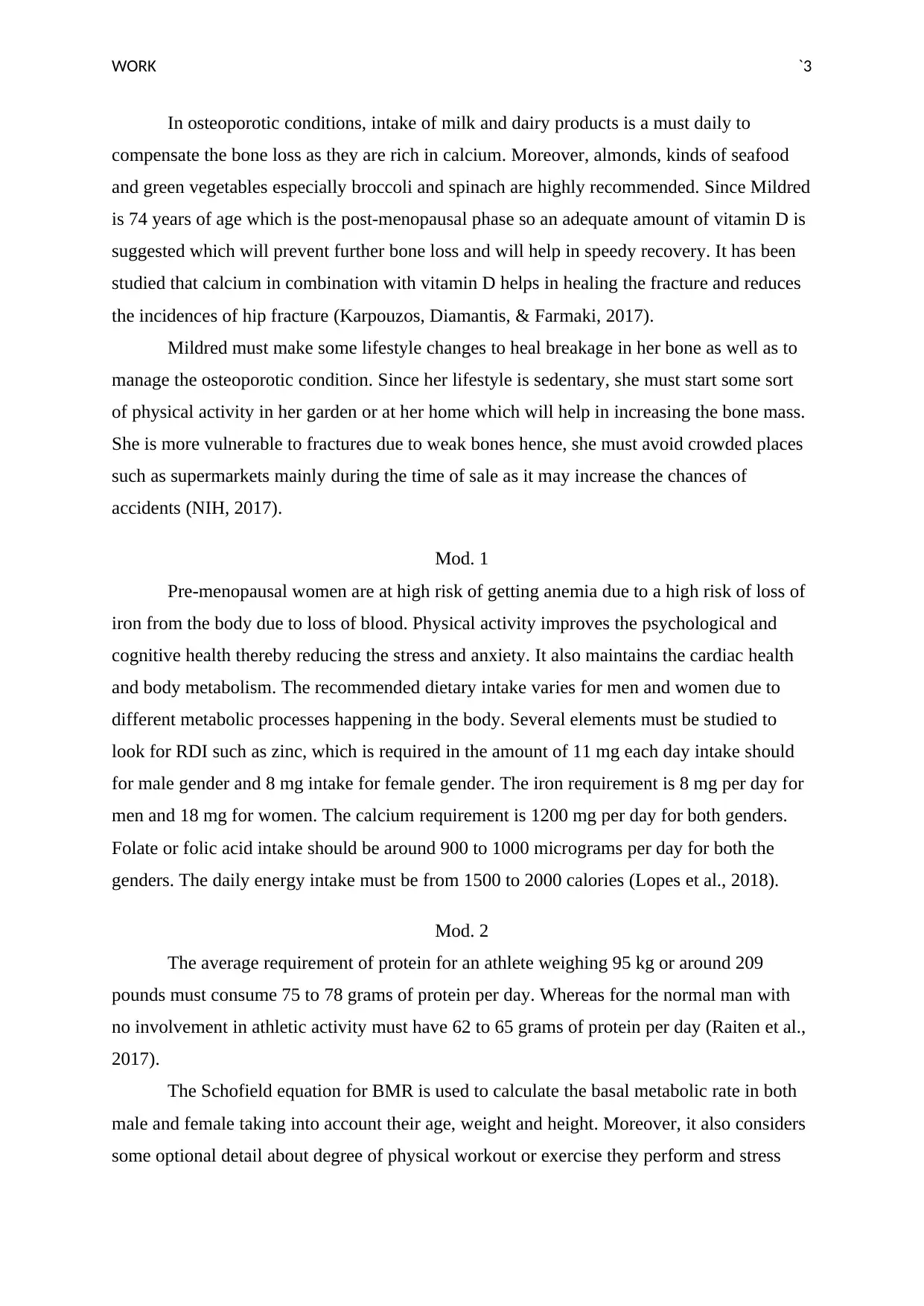
WORK `3
In osteoporotic conditions, intake of milk and dairy products is a must daily to
compensate the bone loss as they are rich in calcium. Moreover, almonds, kinds of seafood
and green vegetables especially broccoli and spinach are highly recommended. Since Mildred
is 74 years of age which is the post-menopausal phase so an adequate amount of vitamin D is
suggested which will prevent further bone loss and will help in speedy recovery. It has been
studied that calcium in combination with vitamin D helps in healing the fracture and reduces
the incidences of hip fracture (Karpouzos, Diamantis, & Farmaki, 2017).
Mildred must make some lifestyle changes to heal breakage in her bone as well as to
manage the osteoporotic condition. Since her lifestyle is sedentary, she must start some sort
of physical activity in her garden or at her home which will help in increasing the bone mass.
She is more vulnerable to fractures due to weak bones hence, she must avoid crowded places
such as supermarkets mainly during the time of sale as it may increase the chances of
accidents (NIH, 2017).
Mod. 1
Pre-menopausal women are at high risk of getting anemia due to a high risk of loss of
iron from the body due to loss of blood. Physical activity improves the psychological and
cognitive health thereby reducing the stress and anxiety. It also maintains the cardiac health
and body metabolism. The recommended dietary intake varies for men and women due to
different metabolic processes happening in the body. Several elements must be studied to
look for RDI such as zinc, which is required in the amount of 11 mg each day intake should
for male gender and 8 mg intake for female gender. The iron requirement is 8 mg per day for
men and 18 mg for women. The calcium requirement is 1200 mg per day for both genders.
Folate or folic acid intake should be around 900 to 1000 micrograms per day for both the
genders. The daily energy intake must be from 1500 to 2000 calories (Lopes et al., 2018).
Mod. 2
The average requirement of protein for an athlete weighing 95 kg or around 209
pounds must consume 75 to 78 grams of protein per day. Whereas for the normal man with
no involvement in athletic activity must have 62 to 65 grams of protein per day (Raiten et al.,
2017).
The Schofield equation for BMR is used to calculate the basal metabolic rate in both
male and female taking into account their age, weight and height. Moreover, it also considers
some optional detail about degree of physical workout or exercise they perform and stress
In osteoporotic conditions, intake of milk and dairy products is a must daily to
compensate the bone loss as they are rich in calcium. Moreover, almonds, kinds of seafood
and green vegetables especially broccoli and spinach are highly recommended. Since Mildred
is 74 years of age which is the post-menopausal phase so an adequate amount of vitamin D is
suggested which will prevent further bone loss and will help in speedy recovery. It has been
studied that calcium in combination with vitamin D helps in healing the fracture and reduces
the incidences of hip fracture (Karpouzos, Diamantis, & Farmaki, 2017).
Mildred must make some lifestyle changes to heal breakage in her bone as well as to
manage the osteoporotic condition. Since her lifestyle is sedentary, she must start some sort
of physical activity in her garden or at her home which will help in increasing the bone mass.
She is more vulnerable to fractures due to weak bones hence, she must avoid crowded places
such as supermarkets mainly during the time of sale as it may increase the chances of
accidents (NIH, 2017).
Mod. 1
Pre-menopausal women are at high risk of getting anemia due to a high risk of loss of
iron from the body due to loss of blood. Physical activity improves the psychological and
cognitive health thereby reducing the stress and anxiety. It also maintains the cardiac health
and body metabolism. The recommended dietary intake varies for men and women due to
different metabolic processes happening in the body. Several elements must be studied to
look for RDI such as zinc, which is required in the amount of 11 mg each day intake should
for male gender and 8 mg intake for female gender. The iron requirement is 8 mg per day for
men and 18 mg for women. The calcium requirement is 1200 mg per day for both genders.
Folate or folic acid intake should be around 900 to 1000 micrograms per day for both the
genders. The daily energy intake must be from 1500 to 2000 calories (Lopes et al., 2018).
Mod. 2
The average requirement of protein for an athlete weighing 95 kg or around 209
pounds must consume 75 to 78 grams of protein per day. Whereas for the normal man with
no involvement in athletic activity must have 62 to 65 grams of protein per day (Raiten et al.,
2017).
The Schofield equation for BMR is used to calculate the basal metabolic rate in both
male and female taking into account their age, weight and height. Moreover, it also considers
some optional detail about degree of physical workout or exercise they perform and stress
Secure Best Marks with AI Grader
Need help grading? Try our AI Grader for instant feedback on your assignments.
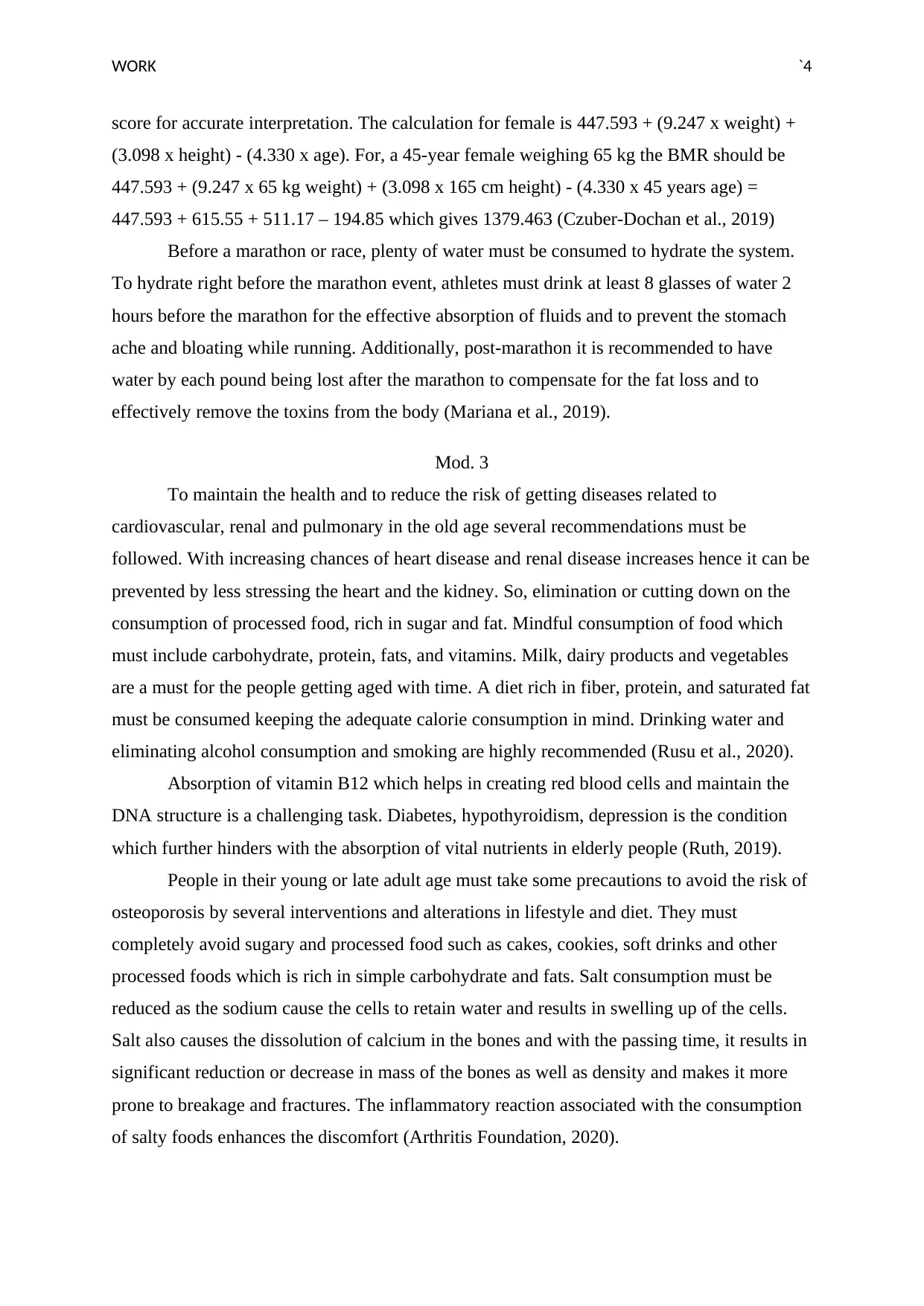
WORK `4
score for accurate interpretation. The calculation for female is 447.593 + (9.247 x weight) +
(3.098 x height) - (4.330 x age). For, a 45-year female weighing 65 kg the BMR should be
447.593 + (9.247 x 65 kg weight) + (3.098 x 165 cm height) - (4.330 x 45 years age) =
447.593 + 615.55 + 511.17 – 194.85 which gives 1379.463 (Czuber‐Dochan et al., 2019)
Before a marathon or race, plenty of water must be consumed to hydrate the system.
To hydrate right before the marathon event, athletes must drink at least 8 glasses of water 2
hours before the marathon for the effective absorption of fluids and to prevent the stomach
ache and bloating while running. Additionally, post-marathon it is recommended to have
water by each pound being lost after the marathon to compensate for the fat loss and to
effectively remove the toxins from the body (Mariana et al., 2019).
Mod. 3
To maintain the health and to reduce the risk of getting diseases related to
cardiovascular, renal and pulmonary in the old age several recommendations must be
followed. With increasing chances of heart disease and renal disease increases hence it can be
prevented by less stressing the heart and the kidney. So, elimination or cutting down on the
consumption of processed food, rich in sugar and fat. Mindful consumption of food which
must include carbohydrate, protein, fats, and vitamins. Milk, dairy products and vegetables
are a must for the people getting aged with time. A diet rich in fiber, protein, and saturated fat
must be consumed keeping the adequate calorie consumption in mind. Drinking water and
eliminating alcohol consumption and smoking are highly recommended (Rusu et al., 2020).
Absorption of vitamin B12 which helps in creating red blood cells and maintain the
DNA structure is a challenging task. Diabetes, hypothyroidism, depression is the condition
which further hinders with the absorption of vital nutrients in elderly people (Ruth, 2019).
People in their young or late adult age must take some precautions to avoid the risk of
osteoporosis by several interventions and alterations in lifestyle and diet. They must
completely avoid sugary and processed food such as cakes, cookies, soft drinks and other
processed foods which is rich in simple carbohydrate and fats. Salt consumption must be
reduced as the sodium cause the cells to retain water and results in swelling up of the cells.
Salt also causes the dissolution of calcium in the bones and with the passing time, it results in
significant reduction or decrease in mass of the bones as well as density and makes it more
prone to breakage and fractures. The inflammatory reaction associated with the consumption
of salty foods enhances the discomfort (Arthritis Foundation, 2020).
score for accurate interpretation. The calculation for female is 447.593 + (9.247 x weight) +
(3.098 x height) - (4.330 x age). For, a 45-year female weighing 65 kg the BMR should be
447.593 + (9.247 x 65 kg weight) + (3.098 x 165 cm height) - (4.330 x 45 years age) =
447.593 + 615.55 + 511.17 – 194.85 which gives 1379.463 (Czuber‐Dochan et al., 2019)
Before a marathon or race, plenty of water must be consumed to hydrate the system.
To hydrate right before the marathon event, athletes must drink at least 8 glasses of water 2
hours before the marathon for the effective absorption of fluids and to prevent the stomach
ache and bloating while running. Additionally, post-marathon it is recommended to have
water by each pound being lost after the marathon to compensate for the fat loss and to
effectively remove the toxins from the body (Mariana et al., 2019).
Mod. 3
To maintain the health and to reduce the risk of getting diseases related to
cardiovascular, renal and pulmonary in the old age several recommendations must be
followed. With increasing chances of heart disease and renal disease increases hence it can be
prevented by less stressing the heart and the kidney. So, elimination or cutting down on the
consumption of processed food, rich in sugar and fat. Mindful consumption of food which
must include carbohydrate, protein, fats, and vitamins. Milk, dairy products and vegetables
are a must for the people getting aged with time. A diet rich in fiber, protein, and saturated fat
must be consumed keeping the adequate calorie consumption in mind. Drinking water and
eliminating alcohol consumption and smoking are highly recommended (Rusu et al., 2020).
Absorption of vitamin B12 which helps in creating red blood cells and maintain the
DNA structure is a challenging task. Diabetes, hypothyroidism, depression is the condition
which further hinders with the absorption of vital nutrients in elderly people (Ruth, 2019).
People in their young or late adult age must take some precautions to avoid the risk of
osteoporosis by several interventions and alterations in lifestyle and diet. They must
completely avoid sugary and processed food such as cakes, cookies, soft drinks and other
processed foods which is rich in simple carbohydrate and fats. Salt consumption must be
reduced as the sodium cause the cells to retain water and results in swelling up of the cells.
Salt also causes the dissolution of calcium in the bones and with the passing time, it results in
significant reduction or decrease in mass of the bones as well as density and makes it more
prone to breakage and fractures. The inflammatory reaction associated with the consumption
of salty foods enhances the discomfort (Arthritis Foundation, 2020).
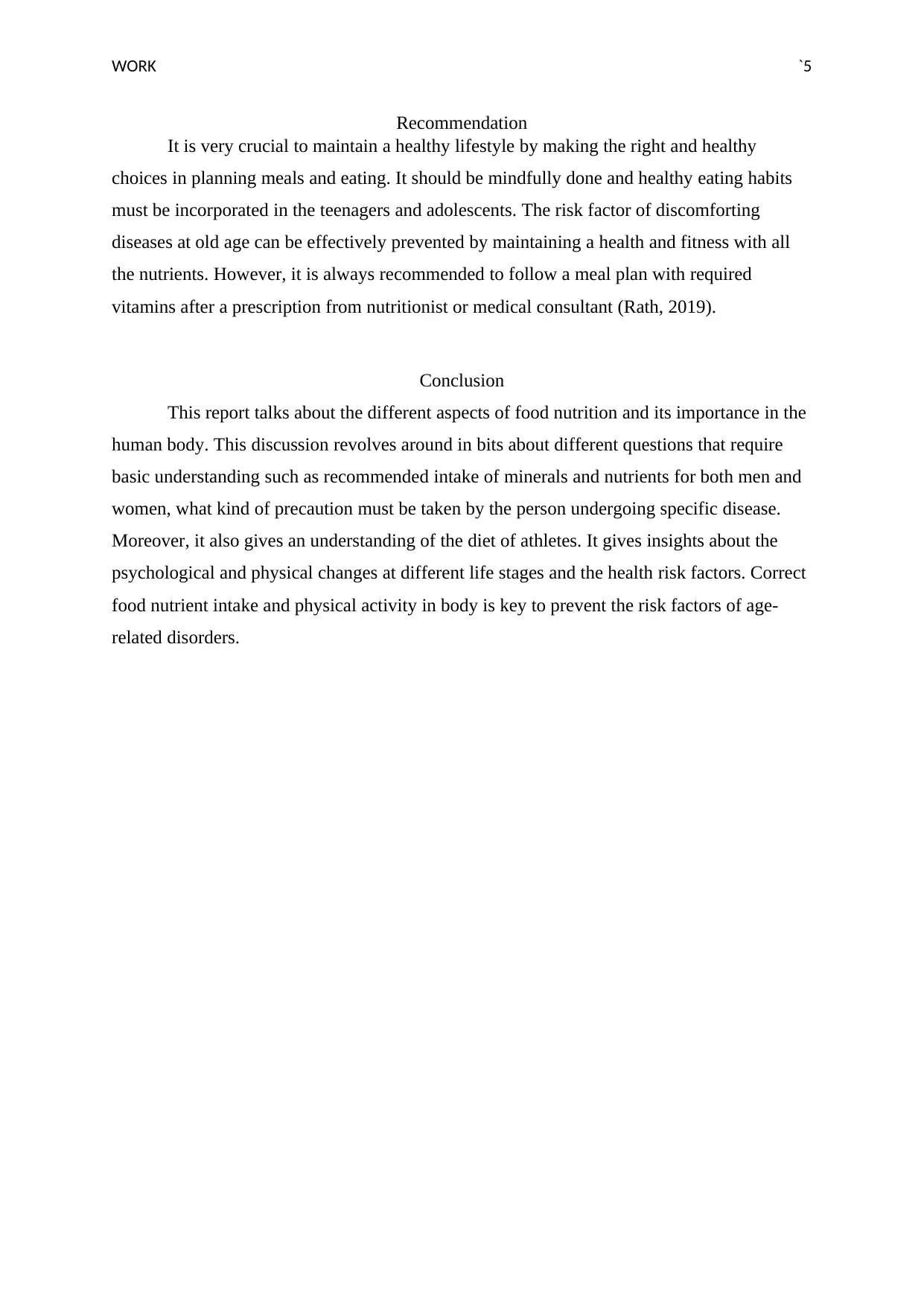
WORK `5
Recommendation
It is very crucial to maintain a healthy lifestyle by making the right and healthy
choices in planning meals and eating. It should be mindfully done and healthy eating habits
must be incorporated in the teenagers and adolescents. The risk factor of discomforting
diseases at old age can be effectively prevented by maintaining a health and fitness with all
the nutrients. However, it is always recommended to follow a meal plan with required
vitamins after a prescription from nutritionist or medical consultant (Rath, 2019).
Conclusion
This report talks about the different aspects of food nutrition and its importance in the
human body. This discussion revolves around in bits about different questions that require
basic understanding such as recommended intake of minerals and nutrients for both men and
women, what kind of precaution must be taken by the person undergoing specific disease.
Moreover, it also gives an understanding of the diet of athletes. It gives insights about the
psychological and physical changes at different life stages and the health risk factors. Correct
food nutrient intake and physical activity in body is key to prevent the risk factors of age-
related disorders.
Recommendation
It is very crucial to maintain a healthy lifestyle by making the right and healthy
choices in planning meals and eating. It should be mindfully done and healthy eating habits
must be incorporated in the teenagers and adolescents. The risk factor of discomforting
diseases at old age can be effectively prevented by maintaining a health and fitness with all
the nutrients. However, it is always recommended to follow a meal plan with required
vitamins after a prescription from nutritionist or medical consultant (Rath, 2019).
Conclusion
This report talks about the different aspects of food nutrition and its importance in the
human body. This discussion revolves around in bits about different questions that require
basic understanding such as recommended intake of minerals and nutrients for both men and
women, what kind of precaution must be taken by the person undergoing specific disease.
Moreover, it also gives an understanding of the diet of athletes. It gives insights about the
psychological and physical changes at different life stages and the health risk factors. Correct
food nutrient intake and physical activity in body is key to prevent the risk factors of age-
related disorders.
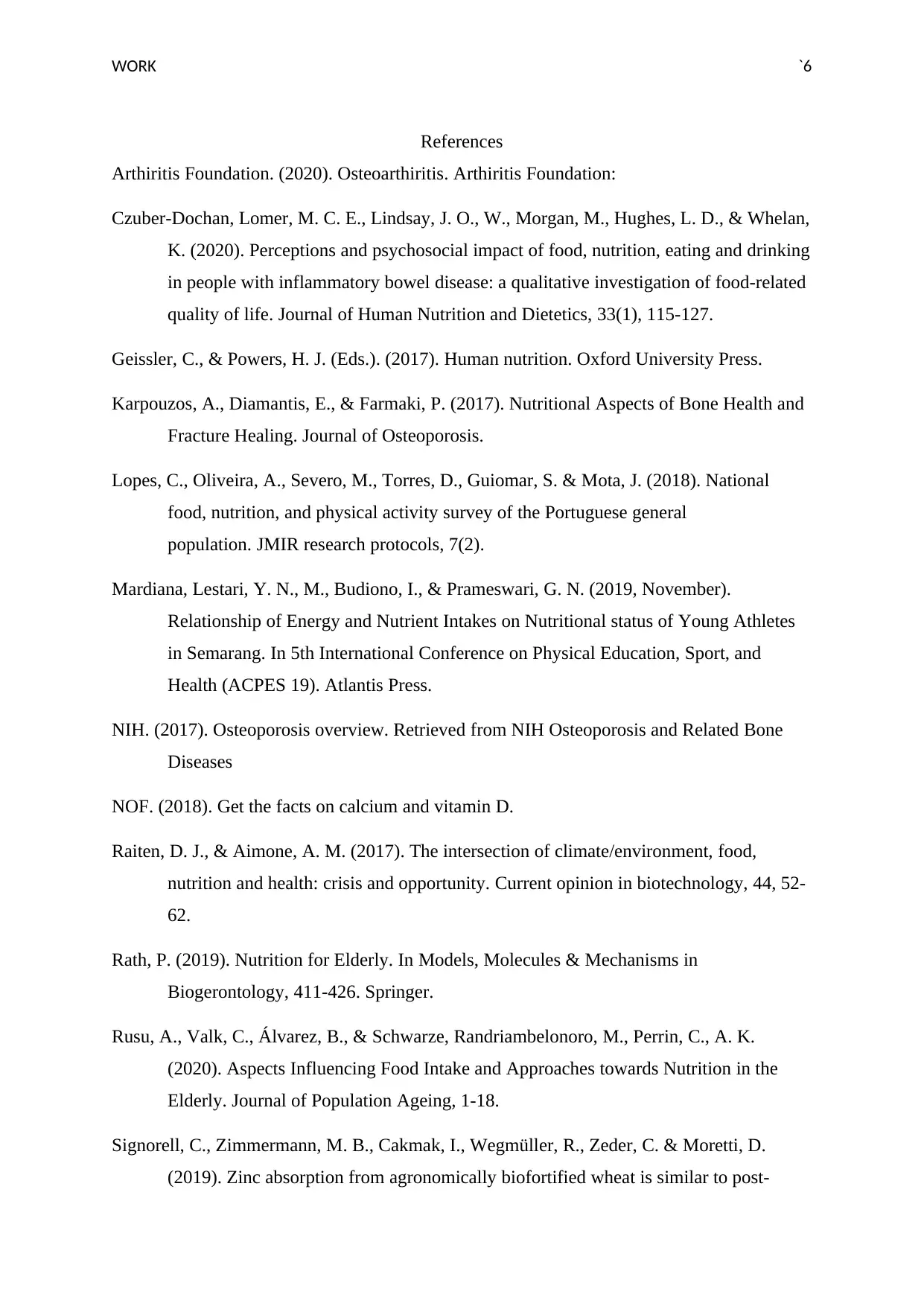
WORK `6
References
Arthiritis Foundation. (2020). Osteoarthiritis. Arthiritis Foundation:
Czuber‐Dochan, Lomer, M. C. E., Lindsay, J. O., W., Morgan, M., Hughes, L. D., & Whelan,
K. (2020). Perceptions and psychosocial impact of food, nutrition, eating and drinking
in people with inflammatory bowel disease: a qualitative investigation of food‐related
quality of life. Journal of Human Nutrition and Dietetics, 33(1), 115-127.
Geissler, C., & Powers, H. J. (Eds.). (2017). Human nutrition. Oxford University Press.
Karpouzos, A., Diamantis, E., & Farmaki, P. (2017). Nutritional Aspects of Bone Health and
Fracture Healing. Journal of Osteoporosis.
Lopes, C., Oliveira, A., Severo, M., Torres, D., Guiomar, S. & Mota, J. (2018). National
food, nutrition, and physical activity survey of the Portuguese general
population. JMIR research protocols, 7(2).
Mardiana, Lestari, Y. N., M., Budiono, I., & Prameswari, G. N. (2019, November).
Relationship of Energy and Nutrient Intakes on Nutritional status of Young Athletes
in Semarang. In 5th International Conference on Physical Education, Sport, and
Health (ACPES 19). Atlantis Press.
NIH. (2017). Osteoporosis overview. Retrieved from NIH Osteoporosis and Related Bone
Diseases
NOF. (2018). Get the facts on calcium and vitamin D.
Raiten, D. J., & Aimone, A. M. (2017). The intersection of climate/environment, food,
nutrition and health: crisis and opportunity. Current opinion in biotechnology, 44, 52-
62.
Rath, P. (2019). Nutrition for Elderly. In Models, Molecules & Mechanisms in
Biogerontology, 411-426. Springer.
Rusu, A., Valk, C., Álvarez, B., & Schwarze, Randriambelonoro, M., Perrin, C., A. K.
(2020). Aspects Influencing Food Intake and Approaches towards Nutrition in the
Elderly. Journal of Population Ageing, 1-18.
Signorell, C., Zimmermann, M. B., Cakmak, I., Wegmüller, R., Zeder, C. & Moretti, D.
(2019). Zinc absorption from agronomically biofortified wheat is similar to post-
References
Arthiritis Foundation. (2020). Osteoarthiritis. Arthiritis Foundation:
Czuber‐Dochan, Lomer, M. C. E., Lindsay, J. O., W., Morgan, M., Hughes, L. D., & Whelan,
K. (2020). Perceptions and psychosocial impact of food, nutrition, eating and drinking
in people with inflammatory bowel disease: a qualitative investigation of food‐related
quality of life. Journal of Human Nutrition and Dietetics, 33(1), 115-127.
Geissler, C., & Powers, H. J. (Eds.). (2017). Human nutrition. Oxford University Press.
Karpouzos, A., Diamantis, E., & Farmaki, P. (2017). Nutritional Aspects of Bone Health and
Fracture Healing. Journal of Osteoporosis.
Lopes, C., Oliveira, A., Severo, M., Torres, D., Guiomar, S. & Mota, J. (2018). National
food, nutrition, and physical activity survey of the Portuguese general
population. JMIR research protocols, 7(2).
Mardiana, Lestari, Y. N., M., Budiono, I., & Prameswari, G. N. (2019, November).
Relationship of Energy and Nutrient Intakes on Nutritional status of Young Athletes
in Semarang. In 5th International Conference on Physical Education, Sport, and
Health (ACPES 19). Atlantis Press.
NIH. (2017). Osteoporosis overview. Retrieved from NIH Osteoporosis and Related Bone
Diseases
NOF. (2018). Get the facts on calcium and vitamin D.
Raiten, D. J., & Aimone, A. M. (2017). The intersection of climate/environment, food,
nutrition and health: crisis and opportunity. Current opinion in biotechnology, 44, 52-
62.
Rath, P. (2019). Nutrition for Elderly. In Models, Molecules & Mechanisms in
Biogerontology, 411-426. Springer.
Rusu, A., Valk, C., Álvarez, B., & Schwarze, Randriambelonoro, M., Perrin, C., A. K.
(2020). Aspects Influencing Food Intake and Approaches towards Nutrition in the
Elderly. Journal of Population Ageing, 1-18.
Signorell, C., Zimmermann, M. B., Cakmak, I., Wegmüller, R., Zeder, C. & Moretti, D.
(2019). Zinc absorption from agronomically biofortified wheat is similar to post-
Paraphrase This Document
Need a fresh take? Get an instant paraphrase of this document with our AI Paraphraser
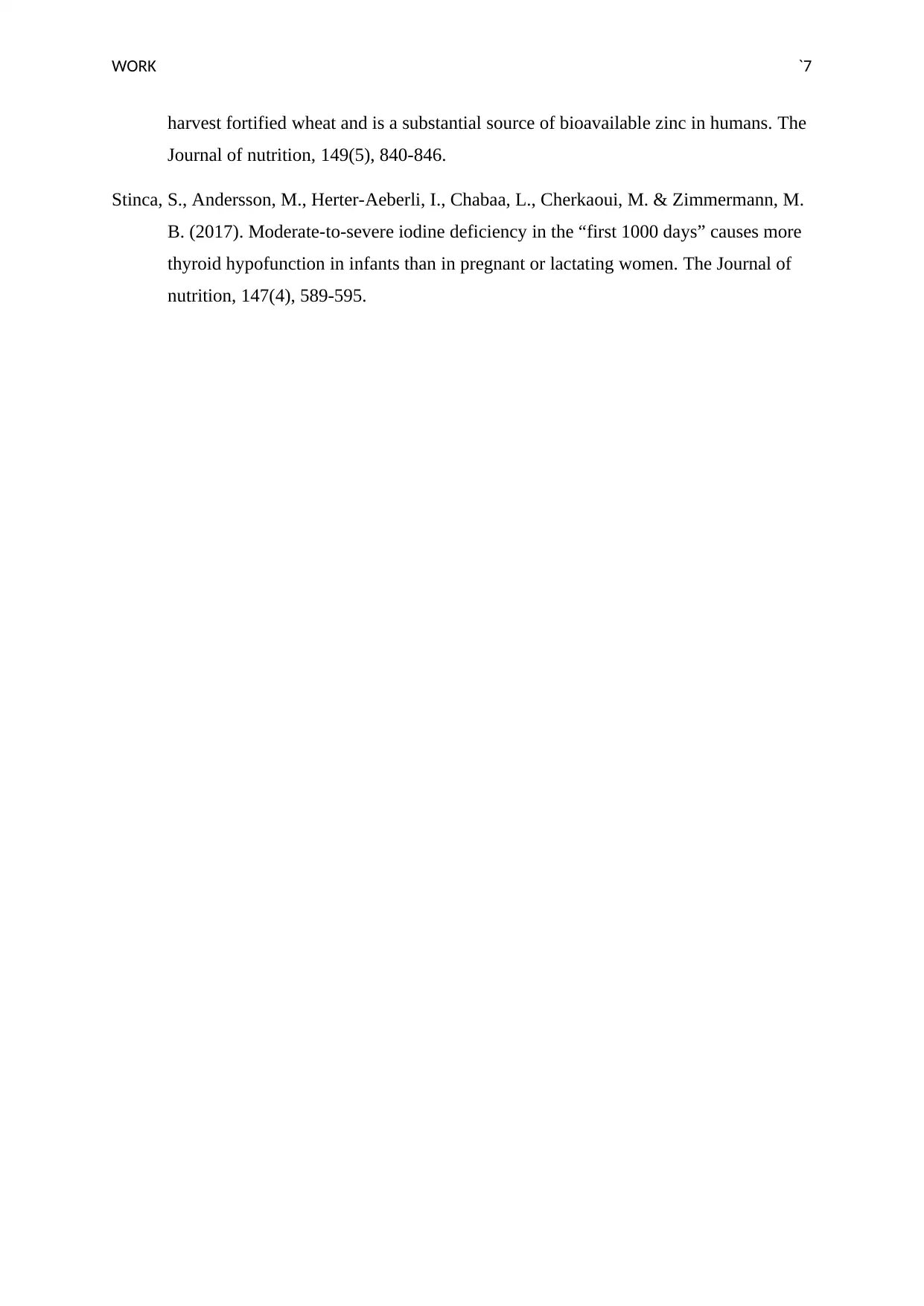
WORK `7
harvest fortified wheat and is a substantial source of bioavailable zinc in humans. The
Journal of nutrition, 149(5), 840-846.
Stinca, S., Andersson, M., Herter-Aeberli, I., Chabaa, L., Cherkaoui, M. & Zimmermann, M.
B. (2017). Moderate-to-severe iodine deficiency in the “first 1000 days” causes more
thyroid hypofunction in infants than in pregnant or lactating women. The Journal of
nutrition, 147(4), 589-595.
harvest fortified wheat and is a substantial source of bioavailable zinc in humans. The
Journal of nutrition, 149(5), 840-846.
Stinca, S., Andersson, M., Herter-Aeberli, I., Chabaa, L., Cherkaoui, M. & Zimmermann, M.
B. (2017). Moderate-to-severe iodine deficiency in the “first 1000 days” causes more
thyroid hypofunction in infants than in pregnant or lactating women. The Journal of
nutrition, 147(4), 589-595.
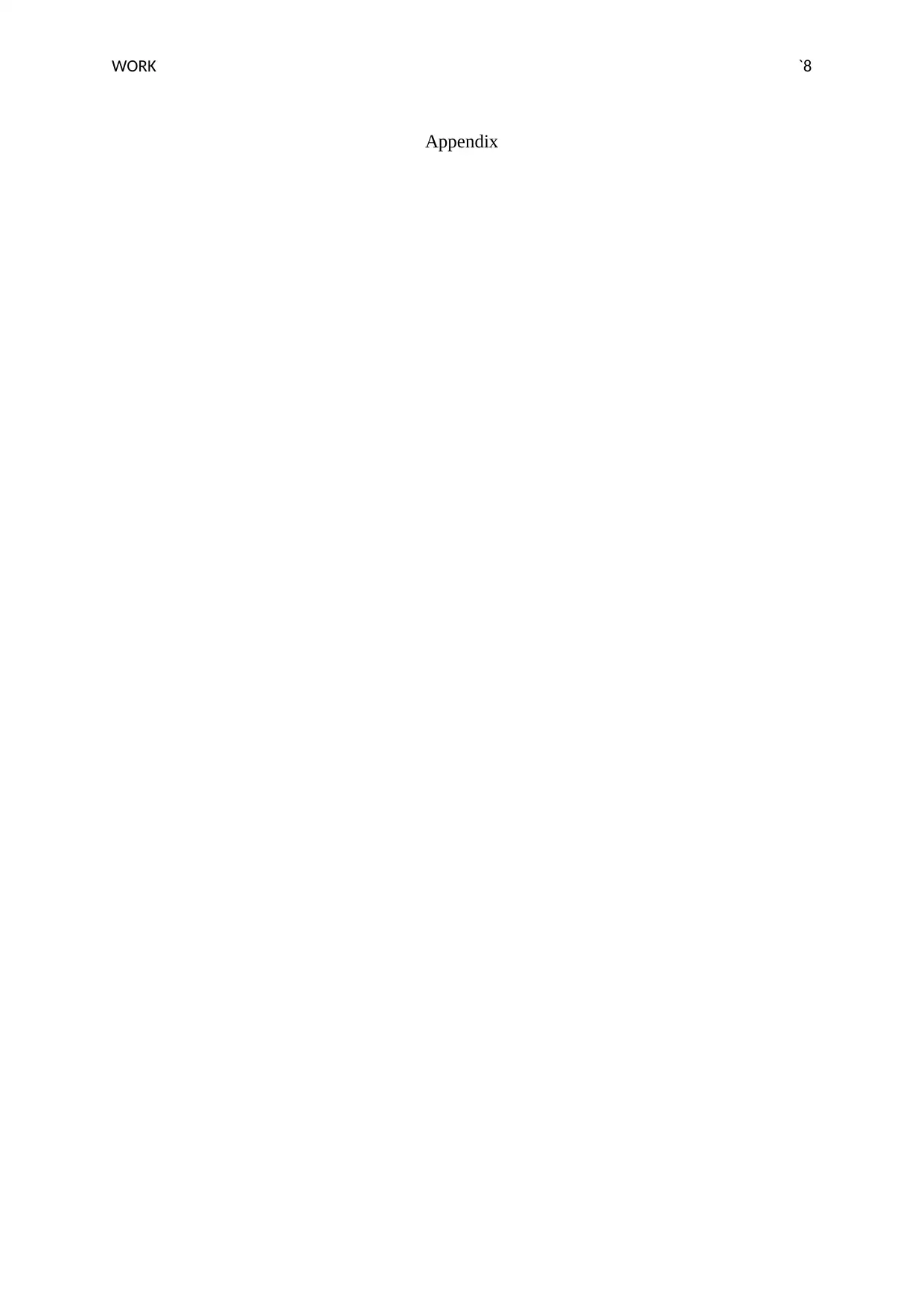
WORK `8
Appendix
Appendix
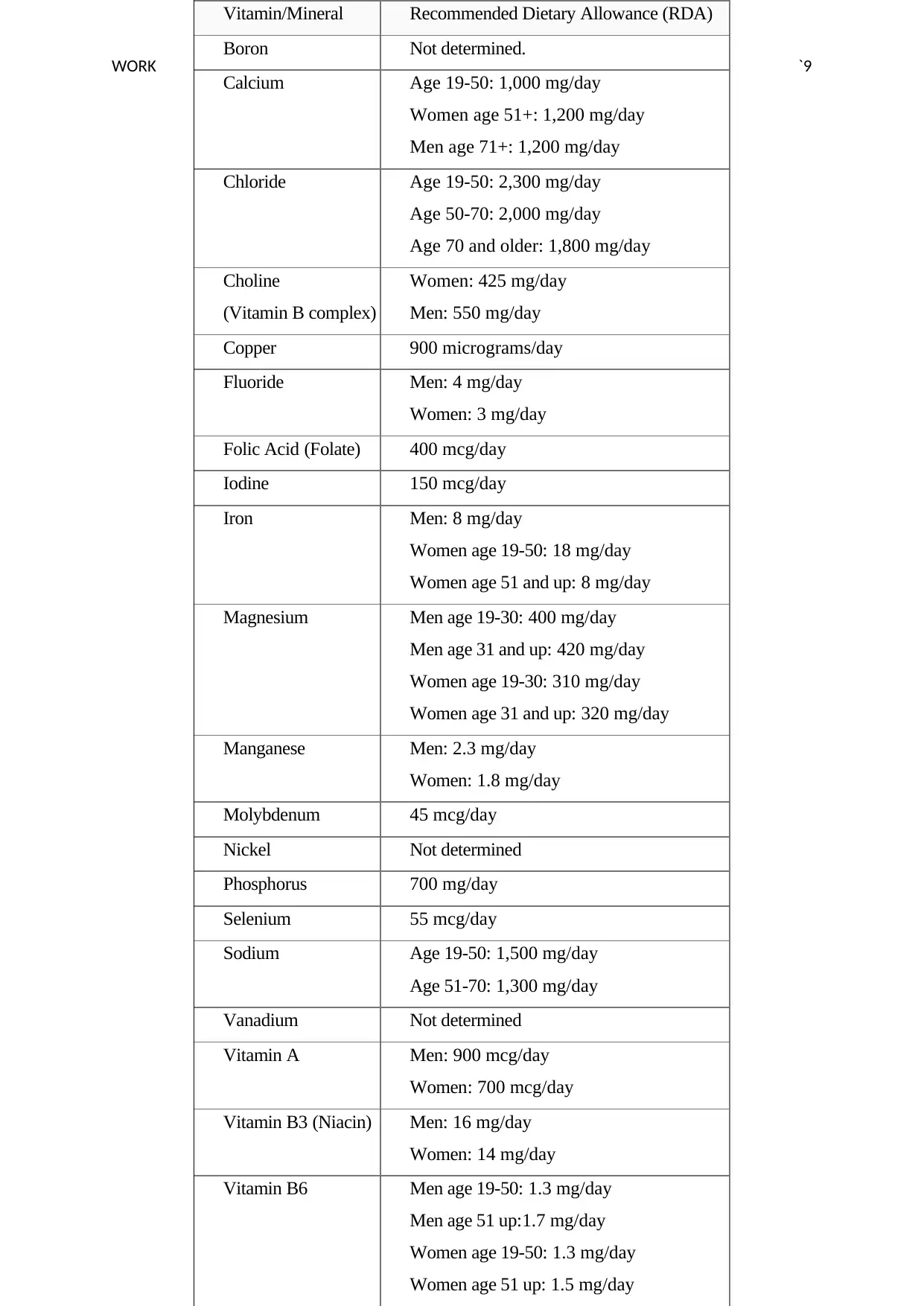
WORK `9
Vitamin/Mineral Recommended Dietary Allowance (RDA)
Boron Not determined.
Calcium Age 19-50: 1,000 mg/day
Women age 51+: 1,200 mg/day
Men age 71+: 1,200 mg/day
Chloride Age 19-50: 2,300 mg/day
Age 50-70: 2,000 mg/day
Age 70 and older: 1,800 mg/day
Choline
(Vitamin B complex)
Women: 425 mg/day
Men: 550 mg/day
Copper 900 micrograms/day
Fluoride Men: 4 mg/day
Women: 3 mg/day
Folic Acid (Folate) 400 mcg/day
Iodine 150 mcg/day
Iron Men: 8 mg/day
Women age 19-50: 18 mg/day
Women age 51 and up: 8 mg/day
Magnesium Men age 19-30: 400 mg/day
Men age 31 and up: 420 mg/day
Women age 19-30: 310 mg/day
Women age 31 and up: 320 mg/day
Manganese Men: 2.3 mg/day
Women: 1.8 mg/day
Molybdenum 45 mcg/day
Nickel Not determined
Phosphorus 700 mg/day
Selenium 55 mcg/day
Sodium Age 19-50: 1,500 mg/day
Age 51-70: 1,300 mg/day
Vanadium Not determined
Vitamin A Men: 900 mcg/day
Women: 700 mcg/day
Vitamin B3 (Niacin) Men: 16 mg/day
Women: 14 mg/day
Vitamin B6 Men age 19-50: 1.3 mg/day
Men age 51 up:1.7 mg/day
Women age 19-50: 1.3 mg/day
Women age 51 up: 1.5 mg/day
Vitamin/Mineral Recommended Dietary Allowance (RDA)
Boron Not determined.
Calcium Age 19-50: 1,000 mg/day
Women age 51+: 1,200 mg/day
Men age 71+: 1,200 mg/day
Chloride Age 19-50: 2,300 mg/day
Age 50-70: 2,000 mg/day
Age 70 and older: 1,800 mg/day
Choline
(Vitamin B complex)
Women: 425 mg/day
Men: 550 mg/day
Copper 900 micrograms/day
Fluoride Men: 4 mg/day
Women: 3 mg/day
Folic Acid (Folate) 400 mcg/day
Iodine 150 mcg/day
Iron Men: 8 mg/day
Women age 19-50: 18 mg/day
Women age 51 and up: 8 mg/day
Magnesium Men age 19-30: 400 mg/day
Men age 31 and up: 420 mg/day
Women age 19-30: 310 mg/day
Women age 31 and up: 320 mg/day
Manganese Men: 2.3 mg/day
Women: 1.8 mg/day
Molybdenum 45 mcg/day
Nickel Not determined
Phosphorus 700 mg/day
Selenium 55 mcg/day
Sodium Age 19-50: 1,500 mg/day
Age 51-70: 1,300 mg/day
Vanadium Not determined
Vitamin A Men: 900 mcg/day
Women: 700 mcg/day
Vitamin B3 (Niacin) Men: 16 mg/day
Women: 14 mg/day
Vitamin B6 Men age 19-50: 1.3 mg/day
Men age 51 up:1.7 mg/day
Women age 19-50: 1.3 mg/day
Women age 51 up: 1.5 mg/day
1 out of 10
Your All-in-One AI-Powered Toolkit for Academic Success.
+13062052269
info@desklib.com
Available 24*7 on WhatsApp / Email
![[object Object]](/_next/static/media/star-bottom.7253800d.svg)
Unlock your academic potential
© 2024 | Zucol Services PVT LTD | All rights reserved.



